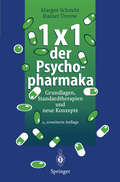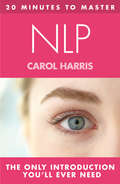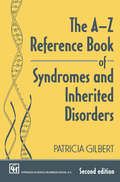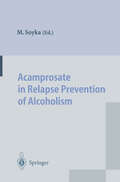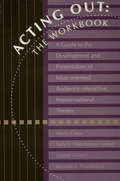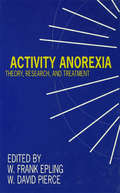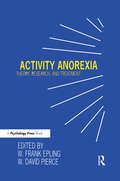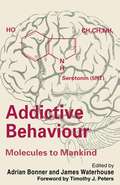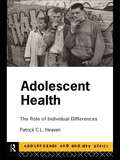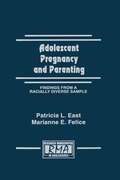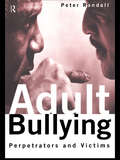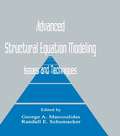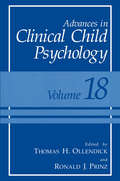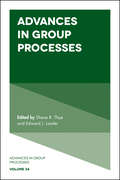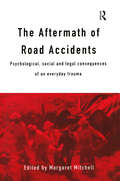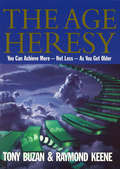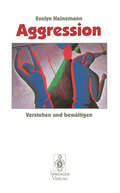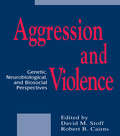- Table View
- List View
1 × 1 der Psychopharmaka: Grundlagen, Standardtherapien und neue Konzepte
by Margot Schmitz Rainer DorowEin handlicher Ratgeber für alle Fragen der Psychopharmakatherapie steht Ihnen mit diesem praktischen 1x1 zur Verfügung. Schritt für Schritt können Sie nachvollziehen, welche Entscheidungen Sie nach klinischen Gesichtspunkten und therapeutischen Überlegungen für eine individuell angemessene Therapie treffen müssen. Dabei werden auch Probleme bei der Behandlung mit Psychopharmaka nicht verschwiegen.Außergewöhnlich viele Fallbeispiele machen die Theorie lebendig. Anschaulichkeit, eine klare Sprache und direkter Praxisbezug kennzeichnen die gesamte Darstellung.Ein Schwerpunkt der Neuauflage ist die Kooperation zwischen Pharmakotherapie und Psychotherapie.
20 MINUTES TO MASTER ... NLP
by Carol HarrisNLP, or Neuro-Linguistic Programming, is an approach to communication, personal development and psychotherapy, allowing you to reach your full potential and achieve your life goals. This book guides you through the core ideas and processes of NLP in an accessible and clear way – and shows you how to master them in just 20 minutes.
Acting Out: A Guide To The Development And Presentation Of Issue-Oriented, Audience- interactive, improvisational theatre
by Mario Cossa Sally Ember Lauren Glass Jennifer RussellFirst published in 1996. Routledge is an imprint of Taylor & Francis, an informa company.
Acting Out: A Guide To The Development And Presentation Of Issue-Oriented, Audience- interactive, improvisational theatre
by Mario Cossa Sally Ember Lauren Glass Jennifer RussellFirst published in 1996. Routledge is an imprint of Taylor & Francis, an informa company.
Activity Anorexia: Theory, Research, and Treatment
by W. David Pierce W. Frank EplingThis volume provides researchers and clinicians with an insight into recent developments in activity anorexia. Much of the basic information on the topic has come from animal literature; the theory of activity anorexia is built on an animal model of self-starvation (rats placed on a single daily feeding run more and more, over days stop eating, and die of starvation). Additionally, experiments that for ethical or practical reasons could not be done with humans may be conducted with other animals. The animal research is extending the understanding of biologically-based reward mechanisms that regulate eating and exercise, environment-behavior interactions that affect anorexia, and the biochemical changes that accompany physical activity and starvation. Increasingly, however, the impact of physical activity on human anorexia is being directly investigated--eight out of fourteen research chapters in this volume are based on human research. Some researchers are interested in the impact of hyperactivity and caloric restriction on human reproductive function. Other authors are investigating physically active subgroups of people considered to be at risk for anorexia. Finally, several clinician/researchers suggest how physical activity and extreme dieting interact for anorexia nervosa patients. Chapter authors were asked to present their views independent of the editors' argument that, when it is present, physical activity is central to anorexia. Many of the contributors disagree with the editors about the details of activity anorexia. A few suggest that excessive physical activity is either incidental to, or an epiphenomenon of, anorexia. Most authors are, however, in accord with the view that physical activity reduces food consumption which further drives up activity that results in even less caloric intake. No matter what their perspective, all contributors agree that hyperactivity frequently accompanies self-starvation in humans and other animals. The end result is a lively book that provides a source of ideas for both researchers and practitioners.
Activity Anorexia: Theory, Research, and Treatment
by W. Frank Epling W. David PierceThis volume provides researchers and clinicians with an insight into recent developments in activity anorexia. Much of the basic information on the topic has come from animal literature; the theory of activity anorexia is built on an animal model of self-starvation (rats placed on a single daily feeding run more and more, over days stop eating, and die of starvation). Additionally, experiments that for ethical or practical reasons could not be done with humans may be conducted with other animals. The animal research is extending the understanding of biologically-based reward mechanisms that regulate eating and exercise, environment-behavior interactions that affect anorexia, and the biochemical changes that accompany physical activity and starvation. Increasingly, however, the impact of physical activity on human anorexia is being directly investigated--eight out of fourteen research chapters in this volume are based on human research. Some researchers are interested in the impact of hyperactivity and caloric restriction on human reproductive function. Other authors are investigating physically active subgroups of people considered to be at risk for anorexia. Finally, several clinician/researchers suggest how physical activity and extreme dieting interact for anorexia nervosa patients. Chapter authors were asked to present their views independent of the editors' argument that, when it is present, physical activity is central to anorexia. Many of the contributors disagree with the editors about the details of activity anorexia. A few suggest that excessive physical activity is either incidental to, or an epiphenomenon of, anorexia. Most authors are, however, in accord with the view that physical activity reduces food consumption which further drives up activity that results in even less caloric intake. No matter what their perspective, all contributors agree that hyperactivity frequently accompanies self-starvation in humans and other animals. The end result is a lively book that provides a source of ideas for both researchers and practitioners.
Addictive Behaviour: Perspectives on the Nature of Addiction
by Adrian Bonner James WaterhouseIn this health-conscious age there is increasing concern about tobacco smoking and inappropriate consumption levels of alcohol. Alcoholism poses an important occupational health problem which can affect an individual's personal welfare and limit his or her efficiency at work. There is concern about the increasing availability of drugs in society, the link between drug-taking and the spread of HIV in society, and the ways in which substance misuse generates more violence within society. Both excessive alcohol consumption and drug-taking may dispose an individual to antisocial actions and lead to criminal activities. By examining the underlying biological and psychological nature of these behaviours the book is intended to inform its readers of current advances in a number of relevant disciplines and to demonstrate some of the problems in collecting and interpreting information from particular groups. 2
Adolescent Health: The Role of Individual Differences (Adolescence and Society)
by Patrick HeavenAdolescence is one of the most turbulent yet exciting phases in life. Increased autonomy brings with it new health risks ranging from drugs and sexually transmitted disease, to eating disorders and suicidal depression. Even though todays teenagers are more concerned with and educated about their health than any previous generation, they still engage in risky behaviour. Adolescent Health explores how individual differences contribute to health and illness across a wide range of cultures and socio-economic backgrounds. Patrick Heaven blends the latest research findings from a range of sources with practical suggestions on how to improve health care services for adolescents. Adolescent Health will prove valuable to professionals working with young people, social science students and parents.
Adolescent Health: The Role of Individual Differences (Adolescence and Society)
by Patrick HeavenAdolescence is one of the most turbulent yet exciting phases in life. Increased autonomy brings with it new health risks ranging from drugs and sexually transmitted disease, to eating disorders and suicidal depression. Even though todays teenagers are more concerned with and educated about their health than any previous generation, they still engage in risky behaviour. Adolescent Health explores how individual differences contribute to health and illness across a wide range of cultures and socio-economic backgrounds. Patrick Heaven blends the latest research findings from a range of sources with practical suggestions on how to improve health care services for adolescents. Adolescent Health will prove valuable to professionals working with young people, social science students and parents.
Adolescent Pregnancy and Parenting: Findings From A Racially Diverse Sample (Research Monographs in Adolescence Series)
by Patricia L. East Marianne E. FeliceWritten by a pediatrician/adolescent medicine specialist and a developmental psychologist, this book is a collection of informative, nonredundant yet comprehensive studies on adolescent pregnancy and parenting. More than 200 adolescent women in an ethnically diverse sample were studied prenatally and at regular 6-month intervals for 3½ years postpartum. Most of the teens were poor, unmarried, first-time mothers who resided within Southeast San Diego, a poor urban area approximately 10 miles north of the U.S.-Mexico border. The purpose of this book was to offer researchers, practitioners, program directors, teachers, and graduate and medical students a better understanding of teenage pregnancy and parenthood within the following domains: * adolescent prenatal care and postpartum maternal and infant health outcomes, * immediate repeat pregnancy, * adolescent mothers' parenting, * the role of the adolescent's mother in teenage mothers' parenting, and * the baby's father.
Adolescent Pregnancy and Parenting: Findings From A Racially Diverse Sample (Research Monographs in Adolescence Series)
by Patricia L. East Marianne E. FeliceWritten by a pediatrician/adolescent medicine specialist and a developmental psychologist, this book is a collection of informative, nonredundant yet comprehensive studies on adolescent pregnancy and parenting. More than 200 adolescent women in an ethnically diverse sample were studied prenatally and at regular 6-month intervals for 3½ years postpartum. Most of the teens were poor, unmarried, first-time mothers who resided within Southeast San Diego, a poor urban area approximately 10 miles north of the U.S.-Mexico border. The purpose of this book was to offer researchers, practitioners, program directors, teachers, and graduate and medical students a better understanding of teenage pregnancy and parenthood within the following domains: * adolescent prenatal care and postpartum maternal and infant health outcomes, * immediate repeat pregnancy, * adolescent mothers' parenting, * the role of the adolescent's mother in teenage mothers' parenting, and * the baby's father.
Adult Bullying: Perpetrators and Victims
by Peter RandallThe frequency and severity of personal harrassment is a problem that is only just beginning to be uncovered. In Adult Bullying, psychologist Peter Randall uses the voices of both bullies and victims to reveal the misery that many adults endure. He describes the processes that turn child bullies into adult bullies, often aware of their behaviour but unable to stop it. The workplace and the neighbourhood replace the playground, but the tactics and patterns of reward remain the same. The adult victim has little or no more power than the child counterpart, often changing jobs to escape the attentions of the bully. Similarly, managers like teachers, often fail to tackle the complaints of the victim with the seriousness the problem deserves, preferring to believe that the fuss is unwarranted. Adult Bullying will be welcomed by managers, counsellors, social workers and anyone who has experienced personal harrassment. Effective ways to deal with bullying in the community and the workplace are discussed, with particular attention given to the implications for managers and employees.
Adult Bullying: Perpetrators and Victims
by Peter RandallThe frequency and severity of personal harrassment is a problem that is only just beginning to be uncovered. In Adult Bullying, psychologist Peter Randall uses the voices of both bullies and victims to reveal the misery that many adults endure. He describes the processes that turn child bullies into adult bullies, often aware of their behaviour but unable to stop it. The workplace and the neighbourhood replace the playground, but the tactics and patterns of reward remain the same. The adult victim has little or no more power than the child counterpart, often changing jobs to escape the attentions of the bully. Similarly, managers like teachers, often fail to tackle the complaints of the victim with the seriousness the problem deserves, preferring to believe that the fuss is unwarranted. Adult Bullying will be welcomed by managers, counsellors, social workers and anyone who has experienced personal harrassment. Effective ways to deal with bullying in the community and the workplace are discussed, with particular attention given to the implications for managers and employees.
Advanced Structural Equation Modeling: Issues and Techniques
by George A. Marcoulides Randall E. SchumackerBy focusing primarily on the application of structural equation modeling (SEM) techniques in example cases and situations, this book provides an understanding and working knowledge of advanced SEM techniques with a minimum of mathematical derivations. The book was written for a broad audience crossing many disciplines, assumes an understanding of graduate level multivariate statistics, including an introduction to SEM.
Advanced Structural Equation Modeling: Issues and Techniques
by George A. Marcoulides Randall E. SchumackerBy focusing primarily on the application of structural equation modeling (SEM) techniques in example cases and situations, this book provides an understanding and working knowledge of advanced SEM techniques with a minimum of mathematical derivations. The book was written for a broad audience crossing many disciplines, assumes an understanding of graduate level multivariate statistics, including an introduction to SEM.
Advances in Clinical Child Psychology: Volume 18 (Advances in Clinical Child Psychology #18)
by Ronald J. Prinz Thomas H. OllendickAs in past volumes, the current volume of Advances in Clinical Child Psychology strives for a broad range of timely topics on the study and treatment of children, adolescents, and families. Volume 18 includes a new array of contributions covering issues pertaining to treatment, etiol ogy, and psychosocial context. The first two contributions address conduct problems. Using quali tative research methods, Webster-Stratton and Spitzer take a unique look at what it is like to be a parent of a young child with conduct problems as well as what it is like to be a participant in a parent training program. Chamberlain presents research on residential and foster-care treatment for adolescents with conduct disorder. As these chapters well reflect, Webster-Stratton, Spitzer, and Chamberlain are all veterans of programmatic research on treatment of child and adolescent conduct problems. Wills and Filer describe an emerging stress-coping model that has been applied to adolescent substance use and is empirically well justi fied. This model has implications for furthering intervention strategies as well as enhancing our scientific understanding of adolescents and the development of substance abuse. Foster, Martinez, and Kulberg confront the issue that researchers face pertaining to race and ethnicity as it relates to our understanding of peer relations. This chapter addresses some of the measurement and conceptual challenges relative to assessing ethnic variables and relating these to social cognitions of peers, friendship patterns, and peer accep tance.
Advances in Group Processes (Advances in Group Processes #34)
by Shane R. Thye Edward J. LawlerAdvances in Group Processes publishes theoretical analyses, reviews and theory-based empirical chapters on group phenomena. The series adopts a broad conception of “group processes.” This includes work on groups ranging from the very small to the very large, and on classic and contemporary topics such as status, power, trust, justice, social influence, identity, decision-making, intergroup relations and social networks. Previous contributors have included scholars from diverse fields including sociology, psychology, political science, economics, business, philosophy, mathematics and organizational behavior. Volume 34 brings together papers that address theoretical and empirical issues related to the spread of status value, reward expectations theory, age and gender effects, and measuring the impact of status manipulations. Other contributions examine cognitive orientation, perspective taking and empathy, the stability of values, and group perceptions during computer-mediated communication. Overall, the volume includes papers that reflect a wide range of theoretical approaches from leading scholars who work in group processes.
Advances in Group Processes: Thirtieth Anniversary Edition (Advances in Group Processes #34)
by Shane R. Thye Edward J. LawlerAdvances in Group Processes publishes theoretical analyses, reviews and theory-based empirical chapters on group phenomena. The series adopts a broad conception of “group processes.” This includes work on groups ranging from the very small to the very large, and on classic and contemporary topics such as status, power, trust, justice, social influence, identity, decision-making, intergroup relations and social networks. Previous contributors have included scholars from diverse fields including sociology, psychology, political science, economics, business, philosophy, mathematics and organizational behavior. Volume 34 brings together papers that address theoretical and empirical issues related to the spread of status value, reward expectations theory, age and gender effects, and measuring the impact of status manipulations. Other contributions examine cognitive orientation, perspective taking and empathy, the stability of values, and group perceptions during computer-mediated communication. Overall, the volume includes papers that reflect a wide range of theoretical approaches from leading scholars who work in group processes.
The Aftermath of Road Accidents: Psychological, Social and Legal Consequences of an Everyday Trauma
by Margaret MitchellAccidents on the road are so common place in our lives today it's easy to believe that there are plenty of support systems in place for the victims. Death and injuries on the road are construed primarily as medico-legal phenomena, re-inforced both by the way accidents are described and by issues of insurance and compensation for damage and personal injury. But there are many profound psychological and social consequences that remain underestimated. Margaret Mitchell has compiled this collection from leading researchers to examine this neglected area for the unseen victims: the families who have to cope with bereavement or a disabled relative, the driver who has killed but is medically uninjured. It will be of great direct value to psychologists, psychiatrists and other health professionals and will serve as a useful reference for those in the legal profession, voluntary associations and those with personal experience of road, traffic, accidents needing advice about where to seek further help.
The Aftermath of Road Accidents: Psychological, Social and Legal Consequences of an Everyday Trauma
by Margaret MitchellAccidents on the road are so common place in our lives today it's easy to believe that there are plenty of support systems in place for the victims. Death and injuries on the road are construed primarily as medico-legal phenomena, re-inforced both by the way accidents are described and by issues of insurance and compensation for damage and personal injury. But there are many profound psychological and social consequences that remain underestimated. Margaret Mitchell has compiled this collection from leading researchers to examine this neglected area for the unseen victims: the families who have to cope with bereavement or a disabled relative, the driver who has killed but is medically uninjured. It will be of great direct value to psychologists, psychiatrists and other health professionals and will serve as a useful reference for those in the legal profession, voluntary associations and those with personal experience of road, traffic, accidents needing advice about where to seek further help.
The Age Heresy: How to Achieve More - Not Less - As You Get Older
by Buzan , Tony And Keene , RaymondIt is widely assumed that as we grow older there is a gradual decline in the way we use our brains. This book draws on acclaimed and proven scientific evidence to put forward a sensational brand-new theory which explodes the myth and shows that, with the right sort of mental and physical exercise, you can actually significantly improve your brain power as you get older. Drawing upon a wealth of fascinating facts and records, with studies of great geniuses such as Einstein and Goethe who improved with age, THE AGE HEARSY is packed with practical advice and guidance on how you can actively learn to enhance your memory, powers of creativity and concentration.
Aggression: Verstehen und bewältigen
by Evelyn HeinemannSind Menschen von Natur aus aggressiv oder wird aggressives Verhalten erst im Laufe des Lebens erlernt? Evelyn Heinemann beschreibt, wie Aggressionen entstehen, wie sich das Aggressionsverhalten von Männern und Frauen unterscheidet und wie andere Kulturen mit Aggression umgehen. Aus ihrer therapeutischen Praxis mit Gewalttätern zeigt sie, welche Wege aus der Gewalt führen.
Aggression and Violence: Genetic, Neurobiological, and Biosocial Perspectives
by David M. Stoff Robert B. CairnsConceived at a time when biological research on aggression and violence was drawn into controversy because of sociopolitical questions about its study, this volume provides an up-to-date account of recent biological studies performed -- mostly on humans. A group of scientists recognized the importance of freedom of inquiry and deemed it vital to address the most promising biological research in the field. The focus on biological mechanisms is not meant to imply that biological variables are paramount as a determinant of violence. Rather, biological variables operate in conjunction with other variables contributing to aggression or violence, and a complete understanding of this phenomenon requires consideration of all influences bearing on it. This book will familiarize readers with the rapidly growing and increasingly significant body of knowledge on the biological bases of human antisocial, aggressive, and violent behaviors. The editors concentrated on biological influences that support the basic physiological and biochemical processes of the brain and did not cover those biological influences that impact on the health of the individual such as head injury, pregnancy and birth complications, diet, and exposure to lead and other toxins. They focused on biological influences to illuminate their role in the complex behavioral phenomenon of violence. Three different approaches to the biological study of human antisocial, aggressive, and violent behaviors are represented -- genetic, neurobiological, and biosocial. Representing each of these three approaches, individual chapters from investigators in psychobiology, biological psychiatry, and basic-clinical neurosciences address the most recent experimental findings, methods, theory, and common misconceptions in the biological study of aggression and violence. The areas of primary focus are behavior and molecular genetics, neurochemistry and hormones, neuroimaging, psychophysiology and developmental psychobiology. Generally speaking, investigators following these different approaches have experience in different scientific backgrounds, select different methods, generate different analyses, employ different conceptual definitions for some of the same terms, and assume a different philosophical stance in attempting to explain violence. Nevertheless, all are united in their efforts to understand the biological underpinnings of violence. This book then assumes a comprehensive approach wherein different levels of analysis and different approaches inform each other. It is clear from the studies reported that aggression and violence are multidetermined phenomena and understanding them requires an interdisciplinary approach spanning economic, sociopolitical, psychological, sociological, and criminological as well as biomedical considerations. Nature (biology) and nurture (experience, context) are fundamentally inseparable in explaining aggression and violence; biology may affect experience or context, but experience or context also influences biology. Both need to be studied in a search for explanations of this phenomena.
